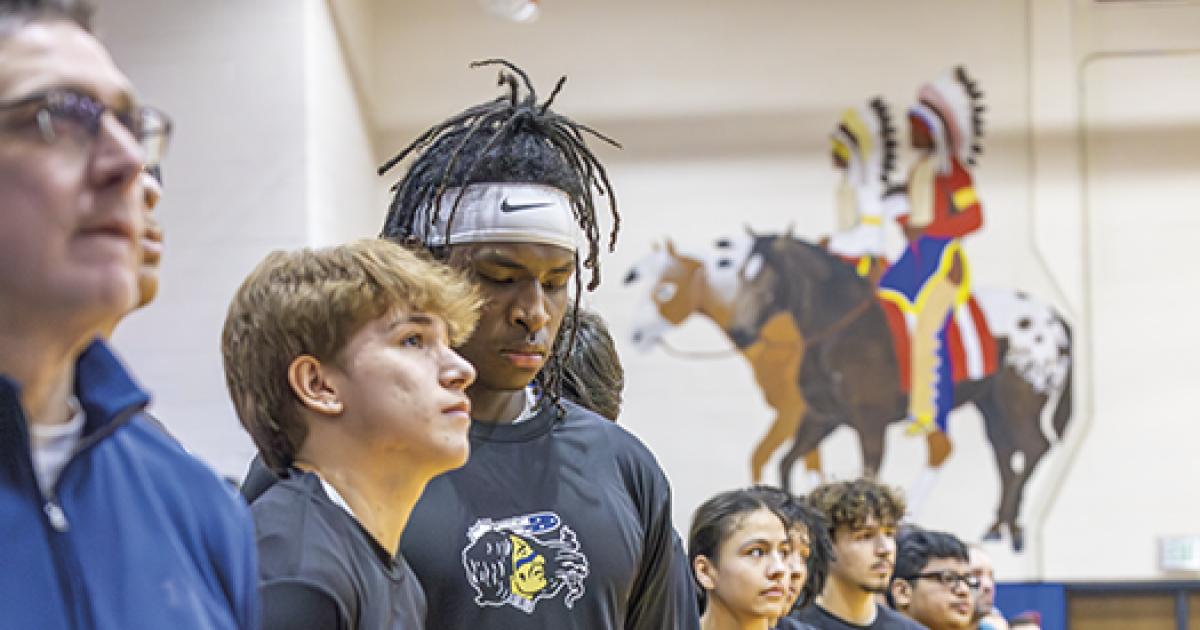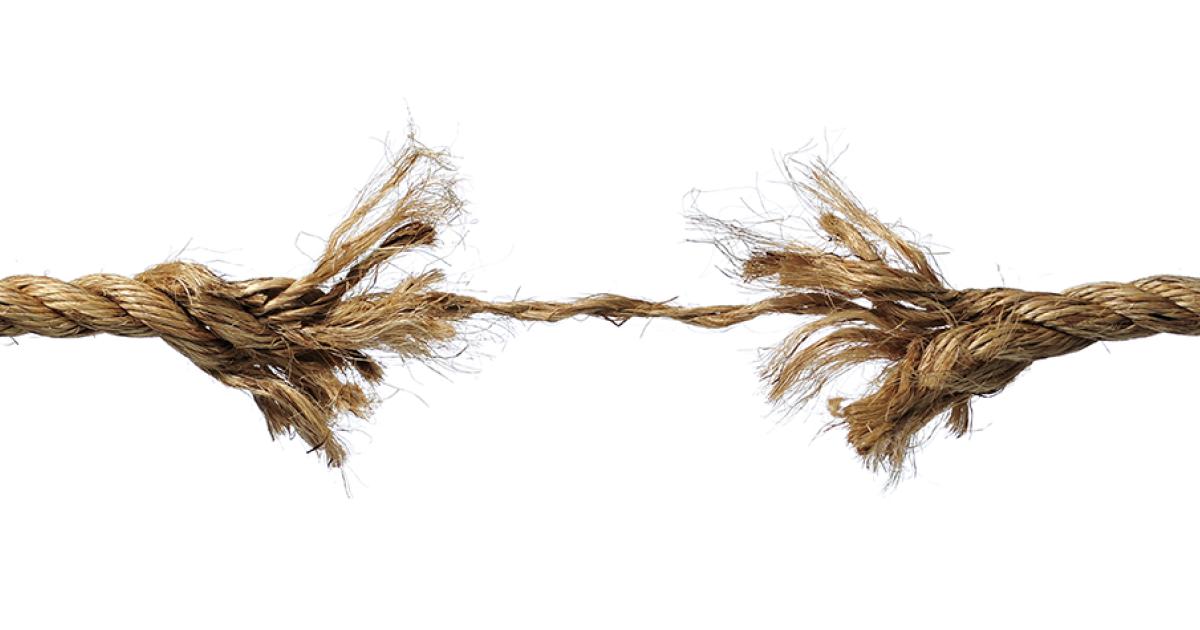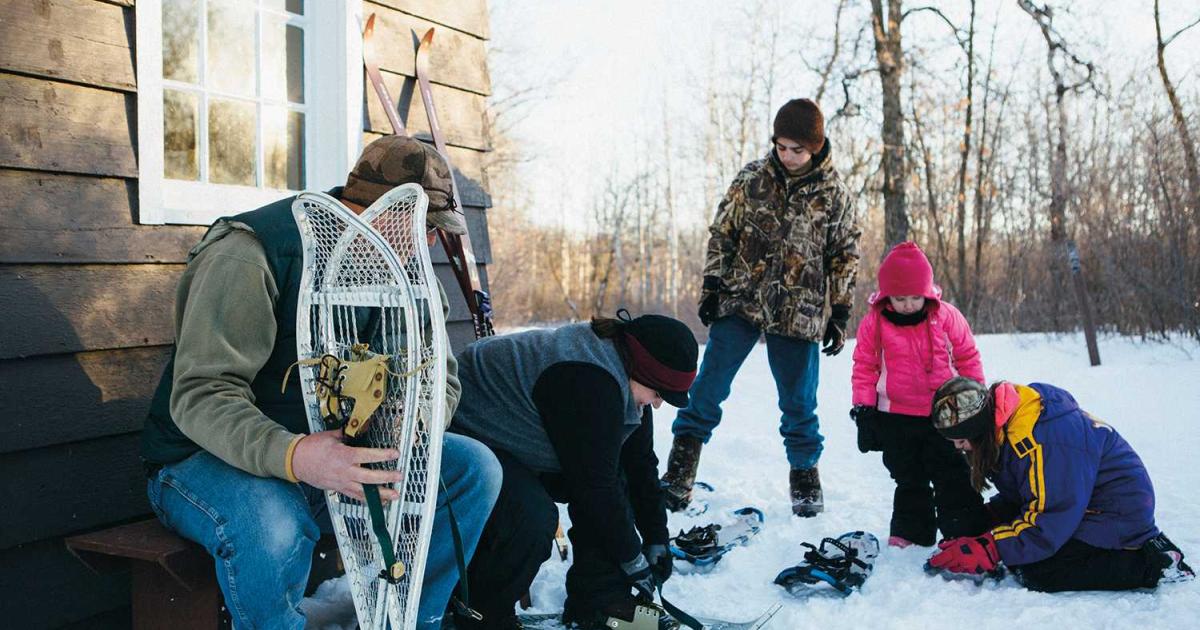Schools, teams compete in three-division basketball system
The Four Winds/Minnewaukan boys basketball team stands for a ceremonial Native American drum performance before a Jan. 6 home game against Standing Rock. Deng Deng (wearing headband) is a standout senior who is on track to graduate at the top of his class. Photo by NDAREC/John Kary
The gym is empty, though not for long. Soon, fans of basketball will fill the stands. But not before Catherine Howard, a Spirit Lake tribal elder, performs a ceremonial smudging of the Four Winds Community School gym.
As the smoke from the burning sweetgrass wafts over the gym, prayers for safety and goodwill bless the space, Four Winds/Minnewaukan Boys Basketball Head Coach Rick Smith explains. Here, Native American culture is alive, preserved and celebrated. It’s painted on the walls, heard in the pregame drum music and evidenced by the kind, respectful manner of players, coaches and fans alike.
Certainly, basketball has become part of their culture, too.
“It goes back a long ways,” Smith says. “In our community, where sometimes hardships get to be more than the positive things going on, basketball has really brought a lot of people together.”
That’s particularly true in Class B basketball, the division in which the Four Winds/Minnewaukan Indians have historically played. Until now. The Indians are among a grouping of high school basketball teams moved up a division, from Division B (formerly Class B) to Division A (the new middle division), with the introduction of a three-division basketball system in North Dakota. The change, which was approved in February 2023 by the North Dakota High School Activities Association (NDHSAA) and championed by a grassroots effort among member schools, was implemented for the 2023-24 season.
High school enrollment numbers are used to determine a school’s classification. Division AA schools have 650 students and higher, Division A schools have between 162.5 and 649 students, and Division B schools have 162.5 students or less. A location adder also applies to public and non-public schools within a Division AA school district, so schools there with 100 to 399 students are placed in Division A and those with 400 or more students are placed in Division AA. Essentially, most smaller schools in larger towns, like Bismarck, Fargo and Minot for example, are excluded from Division B.
Mitch Carlson, superintendent and longtime former head girls basketball coach for LaMoure Public School, was one of two advisors who led the focus group that devised and ultimately pitched the three-division basketball plan to NDHSAA.
“There’s always been an appetite to explore (a three-division basketball system), but I think this is the first true plan that had a lot of input from stakeholders across the state. I think that’s why it was successful,” Carlson says.
DEVISING THE PLAN
In March 2022, a 12-member grassroots committee was created, with Carlson and Josh Johnson, Valley City Public School superintendent, at the helm and one representative from each of the eight Class B basketball regions and the two Class A conferences. The group met biweekly through most of 2022, sent out surveys and gathered input from schools. Most importantly, Carlson says, committee members talked to and shared information with the schools in their local area, seeking to include all stakeholders in the process.
“Everyone had a chance to formulate an opinion and give input, and we put the plan out there and got some feedback and made some changes to it, so it was really a grassroots plan,” Carlson says.
The focus group agreed to present the final plan to NDHSAA if 60% of member schools provided a letter of support. The plan surpassed that threshold with 62% support.
The final plan presented to NDHSAA was ultimately accepted, with a few minor changes – good ones, Carlson says. The focus group’s plan originally called for an enrollment multiplier for non-public schools, which was “probably a sticking point for quite a few schools,” Carlson says. NDHSAA removed the multiplier, opting instead for the location adder, which generally places schools in larger towns in either Division AA or Division A. Without the multiplier, Carlson believes support for the plan would be closer to a 75% to 80% approval rating among member schools.
“A lot of schools have been for the concept of (three-division basketball), but it all depends on how it fits in their system. It always came down to how did it benefit their own individual school,” Carlson says. “In this plan, it benefits the large schools, like the ‘Fargos’ and ‘Bismarcks.’ It benefits the small schools quite a bit. And the middle schools, it’s about half and half, sort of a split in the middle division.”
A reclassification committee was also established by NDHSAA to review petitions from teams to move to a lower division than their enrollment places them, beginning with the 2024-25 season. The first petitions were heard Jan. 16, when four teams asked to be reclassified: Four Winds/Minnewaukan girls, Grand Forks Central girls, Hillsboro girls and Carrington boys. All four petitions failed.
THE ‘B’ IS FOR BOWMAN COUNTY
“This town is a huge basketball town,” Bowman County Girls Basketball Coach Jaci Mrnak says.
Mrnak fits right in.
She was raised in a basketball family on a ranch near the state line in Watauga, S.D., and she’s been in basketball gyms for as long as she can remember. Following in the footsteps of two of her idols – legendary coach Pat Summit and her own junior and senior high school basketball coach, her mom, Heather Katus – Mrnak is in her sixth year coaching for Bowman County.
Last year, the Bowman County girls team earned a trip to the state tournament – their first since 2008.
“Personally, I lost three region championships in a row when I was in high school, so it’s always been a goal of mine to make it to state,” Mrnak says. “I never got to do it as a player, but doing it as a coach has so much more meaning. I’m getting goosebumps talking about it.”
While Mrnak’s Bulldogs are hungry for another state championship run in the “B,” they’ve had to adapt to some change under the new three-division basketball system. The super region format has been eliminated, and the team is putting on more miles to play games.
The schools are being flexible, too. A game on the Bowman County girls schedule has the team playing Kenmare in Beulah – the halfway point for both teams.
Another change in the A and B divisions gives the second- and third-place teams at region tournaments another shot to make it to state. Four additional teams will punch their ticket by winning state qualifier games on the first Saturday following the regional tournaments, Feb. 24 for girls A and B and March 9 for boys A and B, which will pit the region runners-up and third place teams against each other. Under the new format, it’s possible two or three teams from the same region could play in the state tournament.
“I think that will be a really exciting day of basketball,” Carlson says.
Having grown up in a three-division basketball system in South Dakota, Mrnak sees the positives.
“When I would go to the state B tournaments in South Dakota, it was just like a community. You felt together. The town traveled for you. The whole town was at state if you made it,” she says. “I just feel it’s such a better atmosphere for these smaller towns and gives them an opportunity. We’re being handed a huge opportunity right now with our squad, and so are many other schools, like Garrison and Grant County/Mott-Regent and other small towns. It opens a whole new opportunity for Class B, small-town basketball.”
MOVING ON UP?
Smith talks about Class B basketball in North Dakota with a similar fondness.
“The Class B was the last spectacle of North Dakota basketball. It was the pinnacle,” he says. “There’s a history. You got the goliaths that ruled, but every once in awhile, you always have these Cinderella stories to add to that history of Class B basketball.”
Four Winds/Minnewaukan boys basketball, one could argue, is a Cinderella-turned-Goliath story. And Smith has been its main character for 30 years.
“Our program, it’s always been a pretty good program, but it really took off when we got to that first state tournament in ‘06,” he says.
Four Winds made consecutive state tournament appearances from 2006 to 2008, before the team started their co-op with Minnewaukan, which led to seven more state tournaments, including two state championships in 2016 and 2022.
“Getting to the state tournament in the Class B was one of the toughest things to do as a Class B school. … I think any coach who’s been to a state tournament will tell you to get through a regional tournament to get to state is one of the toughest tournaments to play in,” he says.
For now, the Four Winds/Minnewaukan Indians are done writing their story in the scrolls of N.D. Class B basketball history. The team’s next chapter is in the new middle basketball division, where they will encounter five new teams coming down from the higher division – Devils Lake, Turtle Mountain, Valley City, Wahpeton and Watford City.
“When you’ve been in that Class B system for as long as I have, a Class B fan, the biggest thing was, like anything when you go through a big change, everybody’s wondering, ‘How is it going to work?’ ‘Do we need this change?’ ‘Is it going to be successful?’ ‘Is it going to be what the fans want?’ ‘Is it going to be good for the kids, good for the community?’”
Smith admits the three-division concept should allow for more competitive games within each division.
“We’ve always wanted the Devils Lake game in our schedule,” Smith says. “When we played Devils Lake in December, the atmosphere was amazing. This place was rocking. Things like that are going to be good for the sport.”
But the increased travel and scheduling have posed hardships. Longer travel distances have meant more weekend games than before, which requires another level of commitment from coaches and players during a more than three-month-long season. Coordinating referees and venues can be difficult. Weather always plays a role.
Scheduling was one of the biggest challenges out of the gate, Smith says. Most schools are working on their basketball schedules a year in advance, but they were in a holding pattern awaiting the NDHSAA decision in February 2023.
A big test, Smith says, will be the state tournaments. The A and B state tournaments in both girls and boys basketball will now be held on the same day.
“I can remember being in a Class B state championship at the Bismarck (Event) Center, where they had a record of 10,000, 11,000 people in attendance. Will we ever see that again? Probably not, because there’s just too many state tournaments going on at the same time,” Smith says.
Is the three-division basketball system going to work? Time will tell, Smith says.
“If you have the kids in your program, it’s your responsibility as a coach to make it work. … You just do your best to try and make it work, and that’s what we’re trying to do right now,” he says.
Does Smith like his team’s odds to be the first N.D. Division A boys basketball state champions?
“We’re going to work just as hard as anybody to try to get back to the state tournament,” he says.
STUDENT VOICES
Student-athletes Deng Deng, Four Winds/Minnewaukan, and Jaci Fischer, Bowman County, say their game plans haven’t changed since transitioning to a three-division basketball system. They’re working hard at practice, so they can win games and hopefully make it to state. And they’re working hard at school, to prepare for their futures after basketball.
Fischer plans to attend the University of Mary for exercise science. Deng, who is on track to graduate at the top of his class, will work toward a degree and play football at the University of North Dakota.
Certainly, there are things far more important than basketball.
“It goes so much further than basketball. Basketball’s just a game,” Mrnak says. “It’s the relationships and connections that you build with kids and teammates and other players.”
“I’ve met so many nice people, so many people that I call family,” Smith says. “I’m most proud of seeing kids that play on these teams walk across the stage for graduation, even more proud when they go on to college.”
Deng credits Coach Smith for helping him “lock in on the (school) work.” Each practice, Smith reviews student grades with his players.
“At the end of the day, I just want to pave the way for other players in this community to know they can do stuff in college, too, no matter their level or where they’re at,” Deng says.
Find more information on North Dakota high school basketball, including team schedules and tournament dates, on the NDHSSA website at www.ndhsaa.com or by calling the office at 701-845-3953.
___
Cally Peterson is editor of North Dakota Living. She can be reached at cpeterson@ndarec.com.












